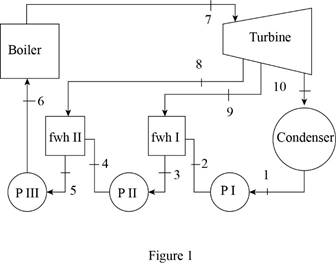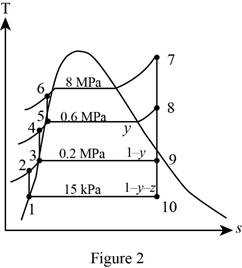
A steam power plant operates on an ideal regenerative Rankine cycle with two open feedwater heaters. Steam enters the turbine at 8 MPa and 550°C and exhausts to the condenser at 15 kPa. Steam is extracted from the turbine at 0.6 and 0.2 MPa. Water leaves both feedwater heaters as a saturated liquid. The mass flow rate of steam through the boiler is 24 kg/s. Show the cycle on a T-s diagram, and determine (a) the net power output of the power plant and (b) the thermal efficiency of the cycle.
(a)
The power output of plant.
Answer to Problem 52P
The power output of the plant is
Explanation of Solution
Draw the schematic diagram of the given ideal regenerative Rankine cycle as shown in
Figure 1.

Draw the
Figure 2.

Here, water (steam) is the working fluid of the regenerative Rankine cycle. The cycle involves three pumps.
Write the formula for work done by the pump during process 1-2.
Here, the specific volume is
Write the formula for enthalpy
Write the formula for work done by the pump during process 3-4.
Here, the specific volume is
Write the formula for enthalpy
Write the formula for work done by the pump during process 5-6.
Here, the specific volume is
Write the formula for enthalpy
At state 9:
The steam expanded to the pressure of
The quality of water at the exit of the turbine (state 9) is expressed as follows.
The enthalpy at state 9 is expressed as follows.
Here, the enthalpy is
At state 10:
The steam enters the condenser at the pressure of
The quality of water at state 10 is expressed as follows.
The enthalpy at state 10 is expressed as follows.
Here, the subscript 10 indicates the process state 10.
Refer Figure 1 and 2.
Write the formula for heat in
Here, the mass fraction steam extracted from the turbine to the feed water entering the boiler via feed water heater-I
Write the general equation of energy balance equation.
Here, the rate of net energy inlet is
At steady state the rate of change of net energy of the system
Refer Equation (XIII).
Write the energy balance equation for open feed water heater-II.
Rewrite the Equation (XIV) in terms of mass fraction
Refer Equation (XIII).
Write the energy balance equation for open feed water heater-I.
Rewrite the Equation (XVI) in terms of mass fraction
Write the formula for net power output of the cycle per unit mass.
Write the formula for net power output of the cycle.
Here, the mass flow rate is
At state 1: (Pump I inlet)
The water exits the condenser as a saturated liquid at the pressure of
Refer Table A-5, “Saturated water-Pressure table”.
The enthalpy
At state 3: (Pump II inlet)
The water exits the open feed water heater-I as a saturated liquid at the pressure of
Refer Table A-5, “Saturated water-Pressure table”.
The enthalpy
At state 5: (Pump III inlet)
The water exits the open feed water heater-II as a saturated liquid at the pressure of
Refer Table A-5, “Saturated water-Pressure table”.
The enthalpy
At state 7:
The steam enters the turbine as superheated vapor.
Refer Table A-6, “Superheated water”.
The enthalpy
From Figure 2.
At state 8:
The steam expanded to the pressure of
Refer Table A-6, “Superheated water”.
The enthalpy
At state 9:
The steam expanded to the pressure of
Refer Table A-5, “Saturated water-Pressure table”.
Obtain the following properties corresponding to the pressure of
At state 10:
The steam enters the condenser at the pressure of
Refer Table A-5, “Saturated water-Pressure table”.
Obtain the following properties corresponding to the pressure of
Conclusion:
Substitute
Substitute
Substitute
Equation (III).
Substitute
Substitute
Equation (V).
Substitute
From Figure 1.
Substitute
Substitute
Equation (VIII).
Substitute
Substitute
Equation (X).
Consider the open feed water heater-II alone.
Substitute
Consider the open feed water heater-I alone.
Substitute
Substitute
Substitute
Substitute
Substitute
Thus, the power output of the plant is
(b)
The thermal efficiency of the cycle.
Answer to Problem 52P
The thermal efficiency of the cycle is
Explanation of Solution
Write the formula for thermal efficiency of the cycle
Conclusion:
Substitute
Thus, the thermal efficiency of the cycle is
Want to see more full solutions like this?
Chapter 10 Solutions
THERMODYNAMICS
- A steam power plant operates on an ideal regenerative Rankine cycle with two open feedwater heaters. Steam enters the turbine at 8 MPa and 550C and exhausts to the condenser at 10 kPa. Steam is extracted from the turbine at 0.6 and 0.2 MPa. Water leaves both feedwater heaters as a saturated liquid. The mass flow rate of steam through the boiler is 16 kg/s. Show the cycle on a T-s diagram, and determine (a) the net power output of the power plant and (b) the thermal efficiency of the cycle.arrow_forwardConsider a steam power plant that operates on a reheat Rankine cycle and has a net power output of 80 MW. Steam enters the high-pressure turbine at 10 MPa and 500°C and the low-pressure turbine at 1 MPa and 500°C. Steam leaves the condenser as a saturated liquid at a pressure of 10 kPa. The isentropic efficiency of the turbine is 80%, and that of the pump is 95 %. Show the cycle on a T-s diagram with respect to saturation lines, and determine (a)the quality (or temperature, if superheated) of the steam at the turbine exit, (b)the thermal efficiency of the cycle, and (c)the mass flow rate of the steam.arrow_forwardConsider a steam power plant operating on the ideal Rankine cycle. Steam enters the turbine at 3 MPa and 623 K and is condensed in the condenser at a pressure of 10 kPa. Determine (i) the thermal efficiency of this power plant, (ii) the thermal efficiency if steam is superheated to 873 K instead of 623 K, and (iii) the thermal efficiency if the boiler pressure is raised to 15 MPa while the turbine inlet temperature is maintained at 873 K.arrow_forward
- Consider a steam power plant that operates on the ideal reheat Rankine cycle. The plant maintains the boiler at 5400 kPa, the reheat section 1100 kPa, and the condenser at 10 kPa. The mixture quality at the exit of both turbines is 94 %. Determine the following values. (1) The specific enthalpy at the exit of the high-pressure turbine. (2) The specific entropy at the exit of the high-pressure turbine. (3) The temperature at the inlet of the high-pressure turbine. (4) The temperature at the inlet of the low-pressure turbine. (5) The thermal efficiency of the cycle.arrow_forwardConsider a steam power plant that operates on an ideal regenerative Rankine cycle and has a net power output of 150 MW. Steam enters the turbine at 10 MPa and 500°C and the condenser at 15 kPa. Steam is extracted from the turbine at 0.5 MPa to heat the feedwater in an open feedwater heater. Water leaves the feedwater heater as a saturated liquid. Show the cycle on a T-s diagram, and determine (a) the mass flow rate of steam through the boiler, and (b) the thermal efficiency of the cycle.arrow_forwardA steam power plant operating on the intermediate steam Rankine cycle produces a net power of 160 MW. Water vapor enters the turbine at a pressure of 15 MPa and a temperature of 600 oC, and the condenser at a pressure of 15 kPa. The isentropic efficiency of the turbine is 85 percent and the isentropic efficiency of the pumps is 90 percent. In order to heat the feed water, some steam is separated from the turbine at a pressure of 0.6 MPa and sent to the open feedwater heater and exits the heater as a saturated liquid. Accordingly, fill in the blanks below. (Pump 1 inlet will be considered as saturated liquid.) a) The mass flow rate of the steam passing through the boiler is m5= ..... kg/s. b) The mass flow rate of the steam separated from the turbine to heat the feed water is m6= ...... kg/s. c) The heat entering the cycle is Qin = ...... kW. d) The heat released from the cycle is Qout = ...... kW. e) The power produced in the turbine is WTurbine= ...... kW. f) The power consumed in…arrow_forward
- How does the thermal efficiency of an ideal Otto cycle change with the compression ratio of the engine and the specific heat ratio of the working fluid?arrow_forwardThermodynamics 2 Consider a steam power plant that operates on a reheat Rankine cycle and has a net power output of 91 MW. Steam enters the high-pressure turbine at 10 MPa and 500 C and the low-pressure turbine at 1 MPa and 500 C. Steam leaves the condenser as a saturated liquid at a pressure of 10 kPa. The isentropic efficiency of the turbine is 95 percent, and that of the pump is 90 percent. The required power input in the pump in MW.arrow_forwardA simple ideal Rankine cycle which uses water as the working fluid operates its condenser at 40C and its boiler at 300C. Calculate the work produced by the turbine, the heat supplied in the boiler, and the thermal efficiency of this cycle when the steam enters the turbine without any superheating.arrow_forward
- 2. A steam power plant operates on the Rankine cycle in which the steam enters the turbine at 16 MPa and 600°C and the condensate leaves the condenser at 10 kPa. If the isentropic efficiency of the turbine is 87 percent and the isentropic efficiency of the pump is 85 percent, determine (a) the thermal efficiency of the cycle and (b) the net power output of the plant for a mass flow rate of 15 kg/s.arrow_forward1. What is the Isentropic Work of the Steam using the Ideal Rankine Cycle when the system is set at 400 kPaa Boiler Pressure and 105 kPaa Condenser Pressure when the system is generating power at 9,500 seconds? 2. With the Turbine work output, what is the Isentropic efficiency of the Turbine from the above settings?arrow_forwardA steam power plant operates on an ideal reheat Rankine cycle between the pressure limits of 14 MPa and 10 kPa. The mass flow rate of steam through the cycle is 10 kg/s. Steam enters both stages of the turbine at 500°C. If the moisture content of the steam at the exit of the low-pressure turbine is not to exceed 12 percent, determine (a) the pressure at which reheating takes place, (b) the total rate of heat input in the boiler, and (c) the thermal efficiency of the cycle. Also, show the cycle on a T-s diagram with respect to saturation lines.arrow_forward
 Elements Of ElectromagneticsMechanical EngineeringISBN:9780190698614Author:Sadiku, Matthew N. O.Publisher:Oxford University Press
Elements Of ElectromagneticsMechanical EngineeringISBN:9780190698614Author:Sadiku, Matthew N. O.Publisher:Oxford University Press Mechanics of Materials (10th Edition)Mechanical EngineeringISBN:9780134319650Author:Russell C. HibbelerPublisher:PEARSON
Mechanics of Materials (10th Edition)Mechanical EngineeringISBN:9780134319650Author:Russell C. HibbelerPublisher:PEARSON Thermodynamics: An Engineering ApproachMechanical EngineeringISBN:9781259822674Author:Yunus A. Cengel Dr., Michael A. BolesPublisher:McGraw-Hill Education
Thermodynamics: An Engineering ApproachMechanical EngineeringISBN:9781259822674Author:Yunus A. Cengel Dr., Michael A. BolesPublisher:McGraw-Hill Education Control Systems EngineeringMechanical EngineeringISBN:9781118170519Author:Norman S. NisePublisher:WILEY
Control Systems EngineeringMechanical EngineeringISBN:9781118170519Author:Norman S. NisePublisher:WILEY Mechanics of Materials (MindTap Course List)Mechanical EngineeringISBN:9781337093347Author:Barry J. Goodno, James M. GerePublisher:Cengage Learning
Mechanics of Materials (MindTap Course List)Mechanical EngineeringISBN:9781337093347Author:Barry J. Goodno, James M. GerePublisher:Cengage Learning Engineering Mechanics: StaticsMechanical EngineeringISBN:9781118807330Author:James L. Meriam, L. G. Kraige, J. N. BoltonPublisher:WILEY
Engineering Mechanics: StaticsMechanical EngineeringISBN:9781118807330Author:James L. Meriam, L. G. Kraige, J. N. BoltonPublisher:WILEY





